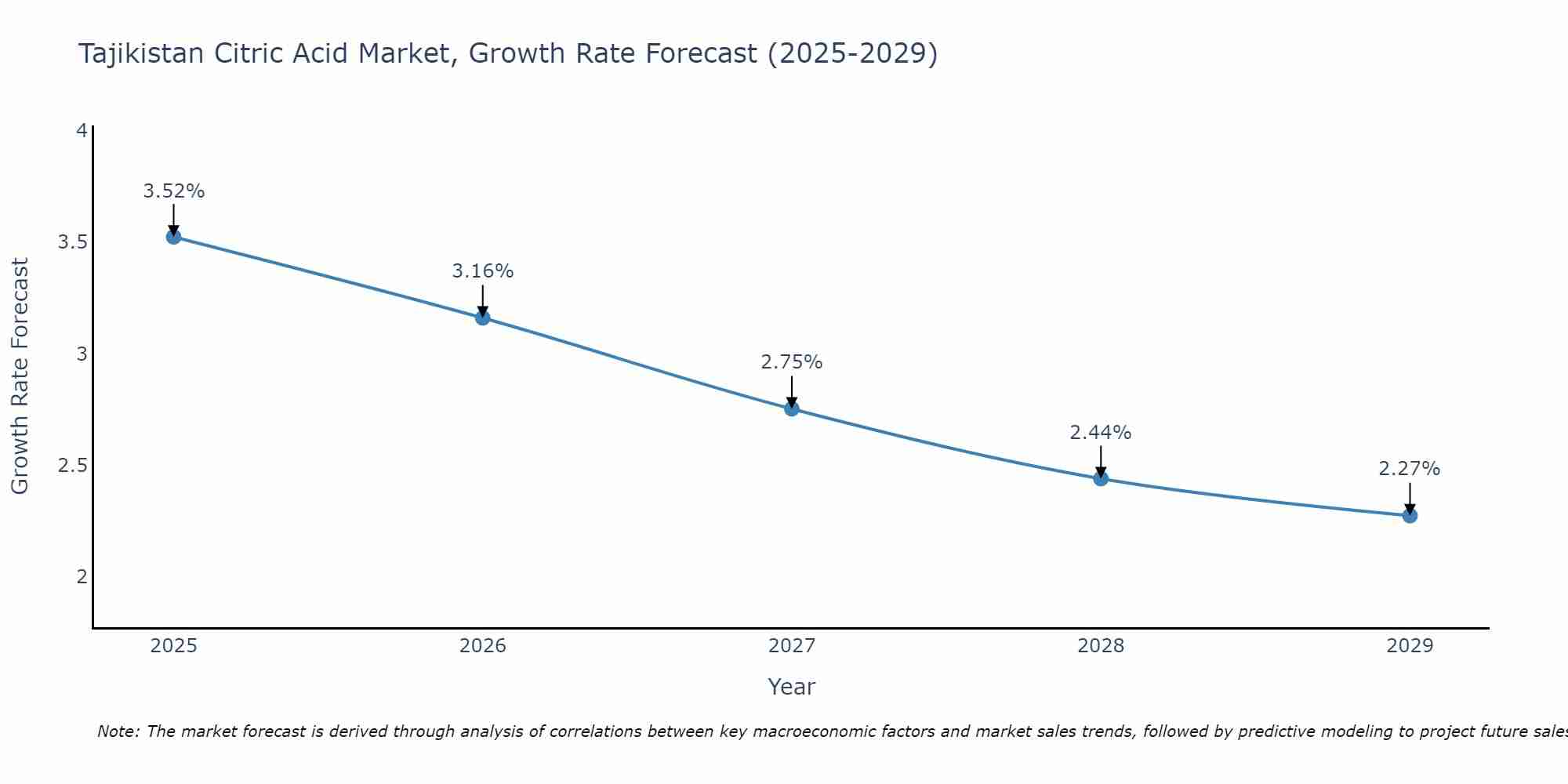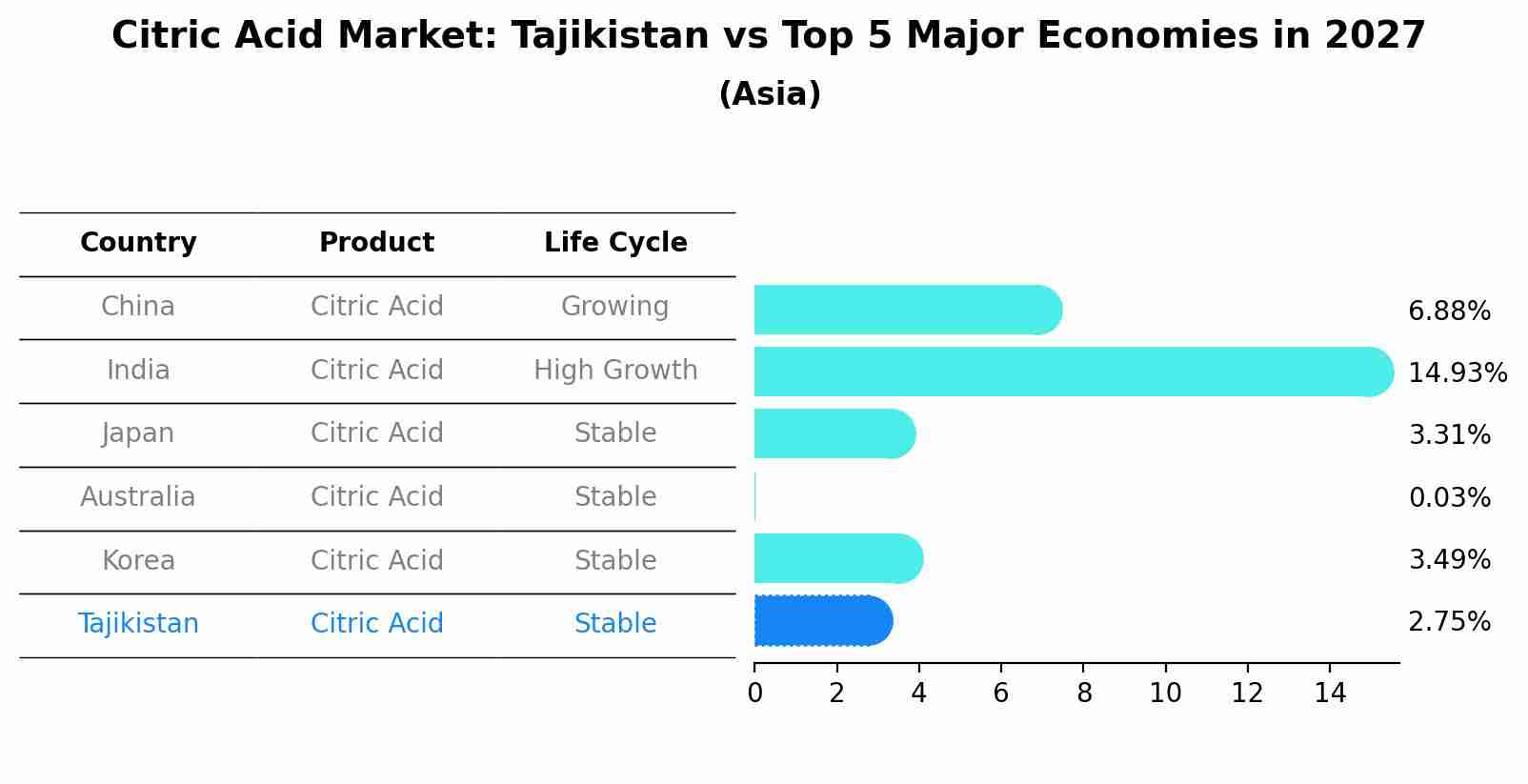Tajikistan Citric Acid Market (2025-2031) Outlook | Trends, Size, Industry, Revenue, Forecast, Growth, Share, Companies, Analysis & Value
| Product Code: ETC130649 | Publication Date: Jun 2021 | Updated Date: Jun 2025 | Product Type: Report | |
| Publisher: 6Wresearch | Author: Summon Dutta | No. of Pages: 70 | No. of Figures: 35 | No. of Tables: 5 |
Tajikistan Citric Acid Market Size Growth Rate
The Tajikistan Citric Acid Market may undergo a gradual slowdown in growth rates between 2025 and 2029. Beginning strongly at 3.52% in 2025, growth softens to 2.27% in 2029.

Citric Acid Market: Tajikistan vs Top 5 Major Economies in 2027 (Asia)
By 2027, the Citric Acid market in Tajikistan is anticipated to reach a growth rate of 2.75%, as part of an increasingly competitive Asia region, where China remains at the forefront, supported by India, Japan, Australia and South Korea, driving innovations and market adoption across sectors.

Tajikistan Citric Acid Market Overview
The Tajikistan citric acid market is seeing steady growth driven by increasing demand from various industries such as food and beverage, pharmaceuticals, and cosmetics. Citric acid is widely used as a flavor enhancer, preservative, and pH regulator in food and beverages, contributing to its high consumption in the country. The pharmaceutical sector also utilizes citric acid in medications and as a buffering agent in various formulations. Additionally, the cosmetic industry incorporates citric acid in skincare products for its exfoliating and antioxidant properties. The market is primarily dominated by imported citric acid due to limited domestic production capacity. However, with the rising demand and potential for local manufacturing, there are opportunities for domestic companies to invest in citric acid production to meet the growing market needs in Tajikistan.
Tajikistan Citric Acid Market Trends
Currently, the Tajikistan Citric Acid market is experiencing steady growth driven by the increasing demand for citric acid in food and beverage applications. The market is witnessing a rise in the consumption of packaged and processed foods, which use citric acid as a preservative and flavor enhancer. Additionally, the growing awareness of the health benefits of natural ingredients is boosting the demand for citric acid as a natural food additive. The market is also seeing a trend towards the use of citric acid in pharmaceuticals and personal care products due to its antimicrobial and antioxidant properties. Overall, the Tajikistan Citric Acid market is expected to continue its growth trajectory in the coming years, driven by the expanding food and beverage industry and the increasing preference for natural ingredients.
Tajikistan Citric Acid Market Challenges
In the Tajikistan Citric Acid Market, challenges are primarily related to limited domestic production capacity, reliance on imports, and fluctuating prices. The country currently lacks sufficient manufacturing facilities for citric acid, leading to a heavy dependence on imports to meet demand. This reliance exposes the market to price volatility due to fluctuations in global supply and demand dynamics. Additionally, infrastructure deficiencies, such as inadequate transportation networks and storage facilities, further hinder the market`s growth and competitiveness. Political instability and regulatory uncertainties can also pose challenges for market players in terms of investment and business operations. Overall, addressing these challenges through strategic investments in production capabilities, supply chain improvements, and regulatory reforms will be crucial for the sustainable development of the Tajikistan Citric Acid Market.
Tajikistan Citric Acid Market Investment Opportunities
The Tajikistan Citric Acid market presents promising investment opportunities due to the country`s growing food and beverage industry, increasing demand for citric acid as a food additive and preservative, and the government`s initiatives to attract foreign investment. With a relatively untapped market, there is potential for investors to capitalize on the rising demand for citric acid in Tajikistan. Additionally, the country`s strategic location along key trade routes offers opportunities for export to neighboring countries in Central Asia and beyond. Investing in citric acid production facilities, distribution networks, or partnering with local manufacturers could prove to be lucrative strategies in this emerging market. Conducting thorough market research and understanding regulatory frameworks will be critical for success in the Tajikistan Citric Acid market.
Tajikistan Citric Acid Market Government Policy
Government policies in Tajikistan related to the citric acid market focus on promoting domestic production and reducing reliance on imports. The government has implemented measures to support local citric acid manufacturers through financial incentives, subsidies, and regulatory support. Additionally, there are policies in place to ensure food safety standards and quality control in citric acid production facilities. The government also aims to boost agricultural productivity to increase the availability of raw materials for citric acid production within the country. Overall, the government`s policies are geared towards fostering the growth of the domestic citric acid industry, enhancing self-sufficiency, and reducing dependency on foreign suppliers in Tajikistan.
Tajikistan Citric Acid Market Future Outlook
The Tajikistan Citric Acid Market is expected to witness steady growth in the coming years due to increasing demand from various end-use industries such as food and beverage, pharmaceuticals, and cosmetics. The market is likely to be driven by factors such as the growing population, changing consumer preferences towards natural and organic products, and the rising awareness about the health benefits of citric acid. Furthermore, the government`s initiatives to promote industrial growth and attract foreign investments are anticipated to support the expansion of the citric acid market in Tajikistan. However, challenges such as fluctuating raw material prices and competition from other citric acid producing countries may pose a threat to the market growth. Overall, the Tajikistan Citric Acid Market is poised for promising opportunities in the foreseeable future.
Key Highlights of the Report:
- Tajikistan Citric Acid Market Outlook
- Market Size of Tajikistan Citric Acid Market, 2021
- Forecast of Tajikistan Citric Acid Market, 2031
- Historical Data and Forecast of Tajikistan Citric Acid Revenues & Volume for the Period 2021 - 2031
- Tajikistan Citric Acid Market Trend Evolution
- Tajikistan Citric Acid Market Drivers and Challenges
- Tajikistan Citric Acid Price Trends
- Tajikistan Citric Acid Porter's Five Forces
- Tajikistan Citric Acid Industry Life Cycle
- Historical Data and Forecast of Tajikistan Citric Acid Market Revenues & Volume By Form for the Period 2021 - 2031
- Historical Data and Forecast of Tajikistan Citric Acid Market Revenues & Volume By Liquid for the Period 2021 - 2031
- Historical Data and Forecast of Tajikistan Citric Acid Market Revenues & Volume By Powder for the Period 2021 - 2031
- Historical Data and Forecast of Tajikistan Citric Acid Market Revenues & Volume By Application for the Period 2021 - 2031
- Historical Data and Forecast of Tajikistan Citric Acid Market Revenues & Volume By Pharmaceutical for the Period 2021 - 2031
- Historical Data and Forecast of Tajikistan Citric Acid Market Revenues & Volume By Food & beverages for the Period 2021 - 2031
- Historical Data and Forecast of Tajikistan Citric Acid Market Revenues & Volume By Others for the Period 2021 - 2031
- Tajikistan Citric Acid Import Export Trade Statistics
- Market Opportunity Assessment By Form
- Market Opportunity Assessment By Application
- Tajikistan Citric Acid Top Companies Market Share
- Tajikistan Citric Acid Competitive Benchmarking By Technical and Operational Parameters
- Tajikistan Citric Acid Company Profiles
- Tajikistan Citric Acid Key Strategic Recommendations
Frequently Asked Questions About the Market Study (FAQs):
Tajikistan Citric Acid |
1 Executive Summary |
2 Introduction |
2.1 Key Highlights of the Report |
2.2 Report Description |
2.3 Market Scope & Segmentation |
2.4 Research Methodology |
2.5 Assumptions |
3 Tajikistan Citric Acid Market Overview |
3.1 Tajikistan Country Macro Economic Indicators |
3.2 Tajikistan Citric Acid Market Revenues & Volume, 2021 & 2031F |
3.3 Tajikistan Citric Acid Market - Industry Life Cycle |
3.4 Tajikistan Citric Acid Market - Porter's Five Forces |
3.5 Tajikistan Citric Acid Market Revenues & Volume Share, By Form, 2021 & 2031F |
3.6 Tajikistan Citric Acid Market Revenues & Volume Share, By Form, 2021 & 2031F |
4 Tajikistan Citric Acid Market Dynamics |
4.1 Impact Analysis |
4.2 Market Drivers |
4.3 Market Restraints |
5 Tajikistan Citric Acid Market Trends |
6 Tajikistan Citric Acid Market, By Types |
6.1 Tajikistan Citric Acid Market, By Form |
6.1.1 Overview and Analysis |
6.1.2 Tajikistan Citric Acid Market Revenues & Volume, By Form, 2018 - 2027F |
6.1.3 Tajikistan Citric Acid Market Revenues & Volume, By Liquid, 2018 - 2027F |
6.1.4 Tajikistan Citric Acid Market Revenues & Volume, By Powder, 2018 - 2027F |
6.2 Tajikistan Citric Acid Market, By Application |
6.2.1 Overview and Analysis |
6.2.2 Tajikistan Citric Acid Market Revenues & Volume, By Pharmaceutical, 2018 - 2027F |
6.2.3 Tajikistan Citric Acid Market Revenues & Volume, By Food & beverages, 2018 - 2027F |
6.2.4 Tajikistan Citric Acid Market Revenues & Volume, By Others, 2018 - 2027F |
7 Tajikistan Citric Acid Market Import-Export Trade Statistics |
7.1 Tajikistan Citric Acid Market Export to Major Countries |
7.2 Tajikistan Citric Acid Market Imports from Major Countries |
8 Tajikistan Citric Acid Market Key Performance Indicators |
9 Tajikistan Citric Acid Market - Opportunity Assessment |
9.1 Tajikistan Citric Acid Market Opportunity Assessment, By Form, 2021 & 2031F |
9.2 Tajikistan Citric Acid Market Opportunity Assessment, By Application, 2021 & 2031F |
10 Tajikistan Citric Acid Market - Competitive Landscape |
10.1 Tajikistan Citric Acid Market Revenue Share, By Companies, 2021 |
10.2 Tajikistan Citric Acid Market Competitive Benchmarking, By Operating and Technical Parameters |
11 Company Profiles |
12 Recommendations |
13 Disclaimer |
- Single User License$ 1,995
- Department License$ 2,400
- Site License$ 3,120
- Global License$ 3,795
Search
Thought Leadership and Analyst Meet
Our Clients
Related Reports
- Afghanistan Rocking Chairs And Adirondack Chairs Market (2026-2032) | Size & Revenue, Competitive Landscape, Share, Segmentation, Industry, Value, Outlook, Analysis, Trends, Growth, Forecast, Companies
- Afghanistan Apparel Market (2026-2032) | Growth, Outlook, Industry, Segmentation, Forecast, Size, Companies, Trends, Value, Share, Analysis & Revenue
- Canada Oil and Gas Market (2026-2032) | Share, Segmentation, Value, Industry, Trends, Forecast, Analysis, Size & Revenue, Growth, Competitive Landscape, Outlook, Companies
- Germany Breakfast Food Market (2026-2032) | Industry, Share, Growth, Size, Companies, Value, Analysis, Revenue, Trends, Forecast & Outlook
- Australia Briquette Market (2025-2031) | Growth, Size, Revenue, Forecast, Analysis, Trends, Value, Share, Industry & Companies
- Vietnam System Integrator Market (2025-2031) | Size, Companies, Analysis, Industry, Value, Forecast, Growth, Trends, Revenue & Share
- ASEAN and Thailand Brain Health Supplements Market (2025-2031) | Strategy, Consumer Insights, Analysis, Investment Trends, Opportunities, Growth, Size, Share, Industry, Revenue, Segments, Value, Segmentation, Supply, Forecast, Restraints, Outlook, Competition, Drivers, Trends, Demand, Pricing Analysis, Competitive, Strategic Insights, Companies, Challenges
- ASEAN Bearings Market (2025-2031) | Strategy, Consumer Insights, Analysis, Investment Trends, Opportunities, Growth, Size, Share, Industry, Revenue, Segments, Value, Segmentation, Supply, Forecast, Restraints, Outlook, Competition, Drivers, Trends, Demand, Pricing Analysis, Competitive, Strategic Insights, Companies, Challenges
- Europe Flooring Market (2025-2031) | Outlook, Share, Industry, Trends, Forecast, Companies, Revenue, Size, Analysis, Growth & Value
- Saudi Arabia Manlift Market (2025-2031) | Outlook, Size, Growth, Trends, Companies, Industry, Revenue, Value, Share, Forecast & Analysis
Industry Events and Analyst Meet
Whitepaper
- Middle East & Africa Commercial Security Market Click here to view more.
- Middle East & Africa Fire Safety Systems & Equipment Market Click here to view more.
- GCC Drone Market Click here to view more.
- Middle East Lighting Fixture Market Click here to view more.
- GCC Physical & Perimeter Security Market Click here to view more.
6WResearch In News
- Doha a strategic location for EV manufacturing hub: IPA Qatar
- Demand for luxury TVs surging in the GCC, says Samsung
- Empowering Growth: The Thriving Journey of Bangladesh’s Cable Industry
- Demand for luxury TVs surging in the GCC, says Samsung
- Video call with a traditional healer? Once unthinkable, it’s now common in South Africa
- Intelligent Buildings To Smooth GCC’s Path To Net Zero


















